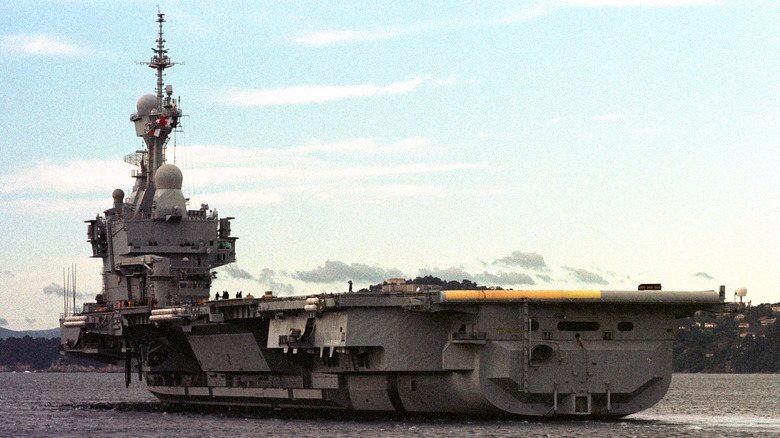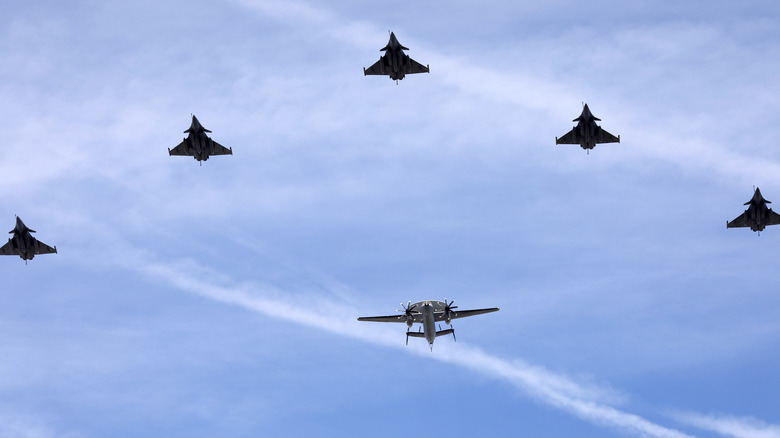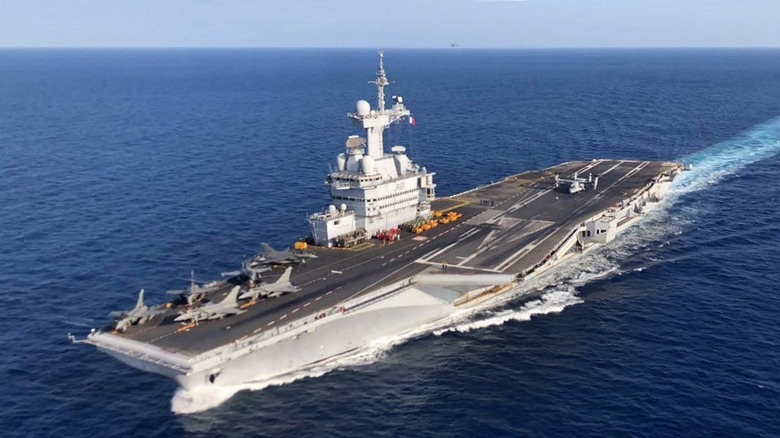All About The Charles De Gaulle Aircraft Carrier And Which Planes It Carries
The Charles de Gaulle aircraft carrier has been proudly serving the French Navy since 2001. While there is a replacement in mind for the French carrier, the Charles de Gaulle will remain in service for decades. American nuclear carriers — France is the only other country with a nuclear aircraft carrier– can typically stay out at sea for two decades before returning to port to refuel, although the French carrier underwent a refuel only six years after her initial deployment. It was much more than a refuel, though, as it also updated the vessel with more modern technology, including new propellers that let it reach a speed of 27 knots.
As a nuclear-powered carrier, the Charles de Gaulle has two nuclear K15 pressure water reactors (PWR). If the ship were to continuously travel at 25 knots, it could go without needing a refuel for five years. The 38,000 ton ship's overall length of 858 feet (261.5 meters) and 211 foot (64.36 meters) beam gives the carrier enough space to carry up to 40 different airframes and house 1,700 crewmembers, 550 of which are part of the air crew. It might be smaller than its American counterparts, but it has done an outstanding job serving as France's sole aircraft carrier for 23 years and will continue to do so until the country's next-generation carrier is ready for duty.
What planes does the Charles de Gaulle carry?
Of the 40 aircraft that the Charles de Gaulle has space for on and under its flight deck, there are three types that are commonly seen aboard. First, there's the Super-Étendard, one of France's first fighter jet with modern weapons. The first version of this fighter jet flew in November 1977 but didn't officially enter service until September 1978. It's an incredibly versatile aircraft that has flown bombings missions on land, assault missions at sea, and filled reconnaissance roles when needed.
The other fighter jet flying carried alongside the Super-Étendard is France's Rafale Marine fighter jet, the closest thing to a fifth generation jet that France has. Initially, the Rafale could only conduct air-to-air missions but it gradually evolved into a true omnirole aircraft with the new F4 iteration that deployed in 2023. It has a max speed of Mach 1.8 and a bevy of weaponry, including an internal 30 mm canon capable of firing 2,500 round per minute, anti-ship missiles, long-range missiles, laser-guided bombs, and non-guided bombs. As such, it can fill an assortment of roles as the French navy sees fit.
Then there's the E-2C Hawkeye early warning aircraft that serves as the navy's eyes, alerting them to other vessels in the area before they're picked up on the carrier's radar. It's a reconnaissance aircraft that can help coordinate missions and relay communications. The French have been using the Hawkeye since 1998, the only other country to do so from an aircraft carrier other than America.
Charles de Gaulle's operational history
Aircraft carriers don't simply bring fighter jets to attack other naval vessels. They're especially useful getting aircraft to land targets, as well. Charles de Gaulle's first deployment saw her participate in Operation Enduring Freedom, from 2001 to 2002. From the Indian Ocean, the carrier catapulted its fighter jets to strike Al Qaeda targets on land. In 2015, the Charles de Gaulle took up a position in the Persian Gulf where it continued to support the U.S. Navy against Islamic State forces operating in Iraq.
Every nation's military commonly runs exercises all around the world to keep the men and women in service sharp and prepared for a number of scenarios. The Charles de Gaulle, along with the rest of its strike group, participated in a NATO-led exercise called Neptune Strike 24-1. The exercise lasted for two weeks between April and May 2024 and was the first time the carrier was under NATO control. During this time, the French carrier had an air wing of 18 Rafale M fighters, two E-2C Hawkeye, and two Dauphin helicopters.
While not as large as something like America's USS Gerald R. Ford, the Charles de Gaulle is more than capable to carrying out a variety of missions with just as capable planes aboard.


